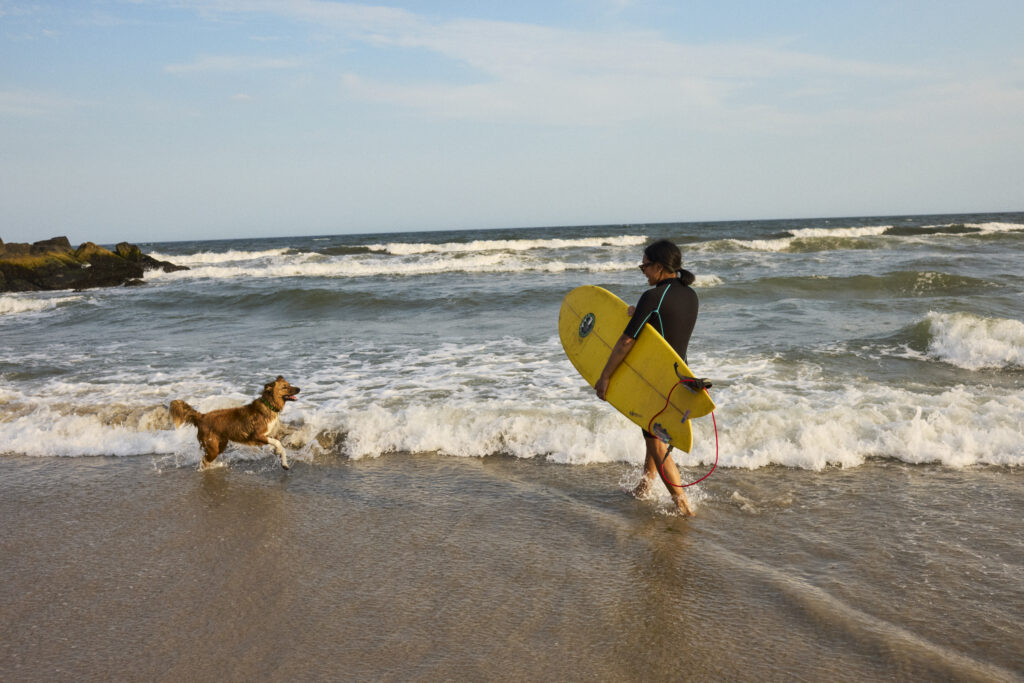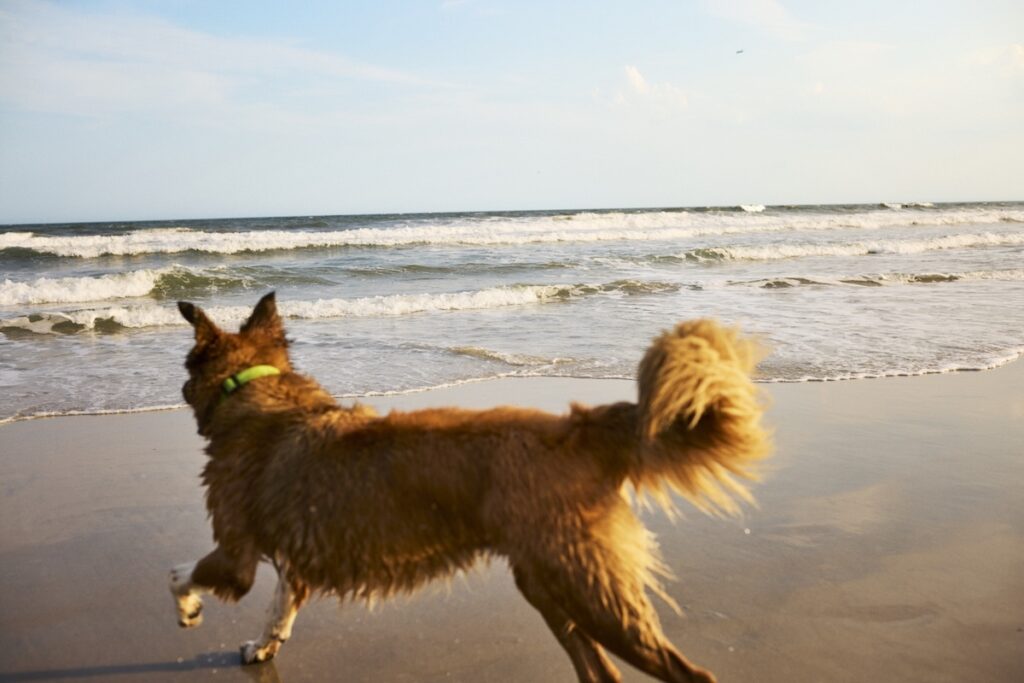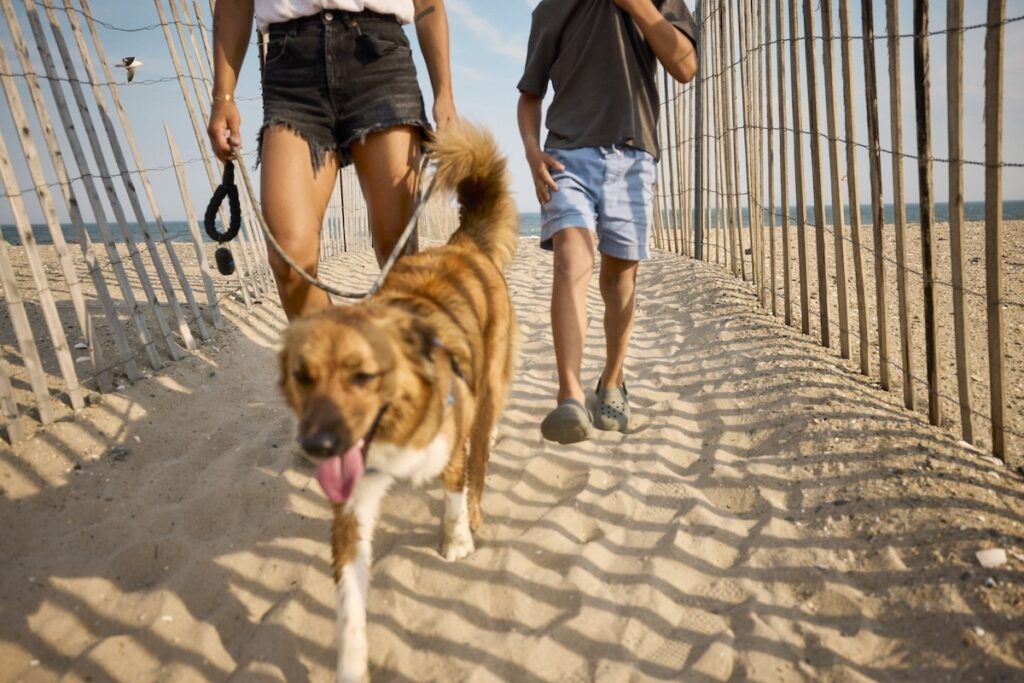In this article:
- Is it too hot to take my dog to the beach?
- What should should I do if my dog gets stung by a jellyfish?
- Do I need to bring shade to the beach for my dog?
- Does my dog need to wear sunscreen?
- What are some good summer snacks for my dog?
- How do I know if my dog has saltwater poisoning?
- Is it dangerous if my dog eats sand?
A beach day with your dog is something special—not least because when a dog loves the beach, they really love the beach. There are plenty of ways to enjoy the sand and surf together, whether you’re walking a group of dogs or taking your one and only for a coastal adventure. Here’s a handy checklist to run through so you can do it all safely while maximizing fun.
Check the temperature, but double-check the heat index
When I spoke with Nancy Soyer, the founder of Brooklyn Dog Walk, the Northeast was in the middle of its first heat wave of the season and temperatures had reached the mid-90s Fahrenheit.
“This is not the time for a beach day,” Soyer said. “It seems like it is, but it’s not.”
Sometimes the beachiest of beach days for a person is not the ideal one for their dog. Though she’s been in business for decades, over the past five years, Soyer has offered a couple of beach field trips a week for its canine clients, who mostly live in the city—and she actually does more beach trips in the winter than the summer.
Brian Collins, DVM, a veterinarian with the Cornell Riney Canine Health Center, agrees that the heat can pose one of the biggest risks for dogs at the beach. He told us that older dogs, overweight dogs, and those with underlying medical conditions like heart and lung disease, are more susceptible to overheating. And short-nosed dogs (also known as brachycephalic breeds) have a higher risk of heatstroke than their longer-nosed peers. Another thing to consider is your dog’s coat. Is it thicker? Shorter? Dark or light? Darker fur heats up faster, and thicker fur tends to as well—though double coats are usually better at regulating a dog’s body temperature than single coats.

Deciding what’s best for your individual dog will depend on considerations like the ones above, but Dr. Collins also provided a rule of thumb: “[G]enerally there is low risk at below 75 degrees Fahrenheit. The risks increase quickly as the temperature rises, and being outside with dogs above 85 degrees should be kept very brief.”
Dr. Collins emphasized that the heat index, or the “feels like” temperature, is “actually a more important consideration, as it takes both temperature and humidity into account.”
He said that a heat index of 80 to 90 degrees Fahrenheit should be considered cautionary, and “anything above that presents a significant risk of heat stroke and should be avoided.”
On those hot, hot summer days, when every fiber of your very human being says “get thee to a beach,” be sure to leave your dog at home in air conditioning with a trusted companion.
Check beach hours and rules
Nothing can tank a perfect beach day like finding out that your dog isn’t allowed to be there—especially after you’ve packed the coolers, loaded the car, and schlepped the stuff. Some beaches have dog hours; some even have dog months. Others have specific leashing rules. Check the beach’s regulations before venturing out.
Check the tides
While you’re doing your research ahead of time, check the tides. Obviously riptides—the strong currents along the coast that can pull people and dogs out to sea—should be avoided.
Likewise, a high tide could seriously limit how much space you and your dog have to run around and have a blast. Soyer said that at the beach she’s been visiting recently, “when the tide goes out, it goes all the way out, and then there’s so much more room to run. When the tide comes in, you can barely get around this little peninsula.”

Check for sea critters
Several types of stinging jellyfish are common in Pacific and Atlantic waters, and curious dogs will sometimes bite down or lick them. Dr. Collins told us that if they’re stung in or around the mouth, they might drool. “Dogs may also vomit, act lethargic, or have trouble breathing,” he added.
One poison hotline for animals in the United Kingdom reported that an influx of barrel jellyfish on British beaches had proven problematic to canine beachgoers. Of the six cases that the hotline addressed in half a year, the most common signs dog owners reported were vomiting or retching, hypersalivation, and edema—or fluid retention—in the face, lips, limbs, and larynx.
A vet can help with pain management if you notice any of the signs mentioned above. Ditto with superficial stings. “Hair and fur will protect dogs to some extent, but they can still be stung in more thinly haired areas,” Dr. Collins said. He recommends removing the tentacles, rinsing the area with salt water, and calling your veterinarian on your way over.
If you notice jellyfish in the sea or on the beach, there might also be dreaded sea lice (no relation to actual lice). These can cause the unfortunately named rash “sunbather’s eruption.” Sea lice are the larvae of thimble jellyfish or sea anemone, and can sting dogs just as well as people.
Though non-life-threatening, the resulting rash can be painful or, at best, annoyingly itchy for a dog. If you notice scratching after a beach day or the telltale red bumps on your dog’s skin, take them to a vet for treatment.
Often, beaches will offer warnings about the presence of jellyfish and incidence of sea lice. A purple flag flying means that there’s dangerous marine life in the waters. While this is usually hoisted due to a man-of-war sighting or stingray presence, it can also mean jellyfish and sea lice.

Shade? Check
Absolutely bring a tent or an umbrella, especially if you plan to be on the beach for the bulk of the day. Keep the shade up the whole time, not only for heat-related reasons, but also to avoid sunburn—and limit how much time your dog spends on dry sand, which can get seriously hot. If there’s no breeze, consider packing a battery-powered fan. (Also: If your dog likes to dig and they don’t get the opportunity to do so very often, they can go wild at the beach. The layers of sand beneath the top tend to be cooler.)
In a peer-reviewed case report on what the authors called “beach feet,” the “Cureus Journal of Medical Science” reported that “Sand can be over 100 degrees Fahrenheit when the outside temperature is only 75 degrees; indeed, when the ambient temperature is 90 degrees, the sand can be over 120 degrees.” Human feet can burn at 111 degrees—and if it’s too hot for humans, it’s too hot for dogs.
Sunscreen? Check
Dogs can get sunburned—especially short-haired dogs like pit bulls and Dalmatians. A dog-safe sunscreen can help prevent this. “Dogs with thick coats may only need it on their nose and ears,” Dr. Collins said. “Light-colored or short-haired dogs may need to have sunscreen applied more widely. It should be applied 15–20 minutes before going into the sun and then reapplied every couple hours or sooner after swimming.”
Any old sunscreen won’t do, since many of them have ingredients toxic to dogs if ingested—like zinc, a gold standard ingredient in sunscreen for humans. Ingredients in sunscreen for dogs include titanium dioxide, benzophenone, octinoxate, and aminobenzoic acid. Note that sunscreen for pets is not evaluated by the Food and Drug Administration, so it won’t come with a specific SPF.
Pet cooling vests, life vests, sun shirts, or rash guards can also protect your dog from the sun—though you may have to patiently use desensitization and counterconditioning to help get them comfortable wearing any new garments.
Snacks? Check
Watermelon, peaches, pineapple, and blueberries are hydrating seasonal fruits that can be enjoyed by dogs and their humans alike.

Check for saltwater poisoning
Saltwater is not good for dogs, but they rarely drink enough for it to become an emergency. For reference, an otherwise healthy 40-pound dog would have to drink over four cups of seawater without any access to fresh water to be in danger.
Still, here are the signs of saltwater poisoning to keep in the back of your mind: Per Cornell University’s Riney Canine Health Center, “Excess salt in the bloodstream pulls water out of brain cells, causing them to shrink.” Dogs have to consume a lot of salt for this to occur, but signs include “muscle tremors, disorientation and seizures.” Dr. Collins added to that list, saying, “Excessive salt intake through ingestion of salt water may cause dogs to feel thirsty and react by drinking more water than normal. Negative effects include vomiting, diarrhea, and lethargy.
This is a life-threatening circumstance, so take your dog directly to the nearest veterinary emergency room if they are showing these signs.
A less serious (but potentially dramatic) side effect of drinking seawater is explosive diarrhea. The magnesium in seawater has a “strong laxative effect,” according to the Riney Canine Health Center, so they recommend taking your dog for a nice, long walk 20 to 30 minutes before getting back in the car to go home.
Diarrhea can be one of the first signs of saltwater ingestion. It also can be an early warning sign of more serious saltwater toxicity, which can escalate quickly. If your dog develops diarrhea after beach play—especially if they also seem overly tired, shaky, or disoriented—skip the walk and go straight to your vet.
The best way to avoid any of this is to be sure to provide plenty of opportunities for your dog to drink fresh water throughout your time at the beach, so they won’t be tempted to suck down the salty stuff.
Check for sand impaction
For some dogs, ball is life. But, occasionally, chasing balls that accumulate sand—or digging and otherwise playing in the sand—can lead to a dog ingesting so much of it that they suffer impaction in their intestinal tract. Pooping out sand after a beach day is normal. Sand impaction, however, is a life-threatening emergency, and one you’ll want to get to the vet immediately to address. Signs include a loss of appetite, lethargy, vomiting, restlessness, and difficulty pooping.
Have fun!
You’ve checked the beach’s rules and regs, your tide chart is in your pocket, and your beach bag is packed. You’ve even whispered the magic words to your dog: “Do you want to go to the beach?” Now, all that’s left to do is to head to the shore. Stay cool out there!




